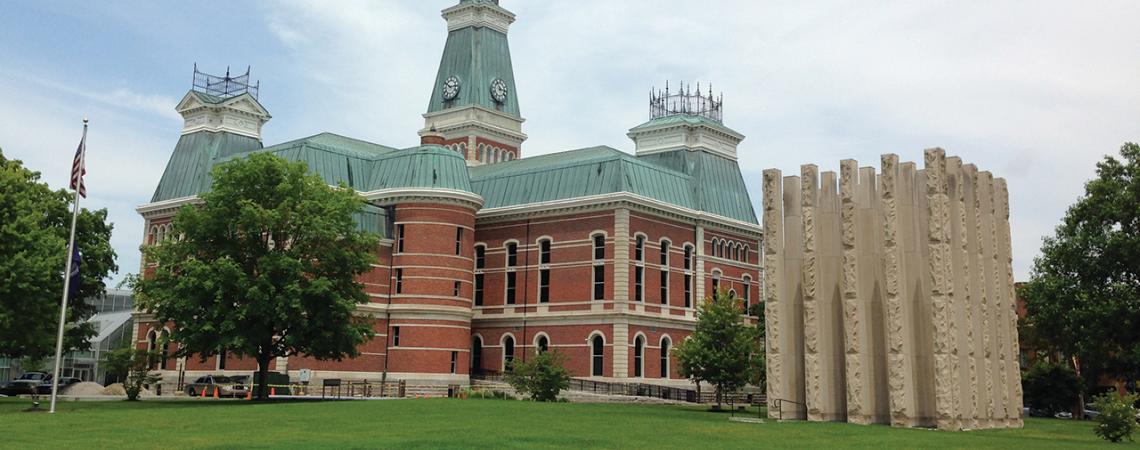Two stunning architectural works, side-by-side in Columbus: The Bartholomew County Courthouse and Veterans Memorial are must-sees on a tour of the city.
When Americans conjure a place called “Columbus,” many imagine Ohio — home of The Ohio State University and its legions of Buckeye football fans.
There is, however, another Columbus not too far away — west across the state line to just south of Indianapolis. While its population is only about 45,000, the town enjoys an outsized reputation as a modern architectural Mecca.
Located just three hours from Ohio’s capital, this Hoosier hamlet has long been a transportation hub — especially for railroads. Its major employer, Cummins, Inc. (f.k.a. Cummins Engine) is an integral part of why this small municipality boasts more than 70 buildings and landscapes designed by celebrity architects from around the globe. Family vacation planners take note: Columbus captivates kids with a massive indoor playground and a three-story children’s museum. The whole family can indulge their sweet teeth at an old-fashioned ice cream parlor with vintage soda fountains.
The best place to start exploring is the Visitors Center on Fifth Street, where visitors may view films on Columbus’ architectural significance and preview one of its crown jewels, the Miller House and Garden. The Visitors Center offers two-hour bus tours that include historic and contemporary structures and tells the backstory of how this place came to be ranked among the world’s top destinations for innovative design.
A brief summary: Local businessman J. Irwin Miller suddenly became the CEO of Cummins Engine during World War II when his great uncle died unexpectedly. After the war, Columbus experienced rapid family growth, and projected a need for new schools. The first two prefabricated schools were built hurriedly. So Miller offered funding for the design of the next one, as long as school board officials would select an architect from a list provided by the Cummins Foundation (the company’s charitable arm). That was the start of renowned modern architects building public structures and art there: I.M. Pei’s Cleo Rogers Memorial Library, Kevin Roche’s Columbus Post Office, and sculptor Henry Moore’s “Large Arch” that unifies the plaza between the groundbreaking First Christian Church (designed by Finnish architect Eliel Saarinen) and the library.
A must-see is the Miller House and Garden designed by Eero Saarinen, Eliel’s son. Eero gained international recognition for St. Louis’s Gateway Arch and the TWA Flight Center at JFK International Airport, and was crucial in selecting Jorn Utzon to design the Sydney Opera House. Among architecture aficionados, Miller House is as revered as Frank Lloyd Wright’s iconic Fallingwater in Western Pennsylvania.
Travelers who visit this summer and fall will experience the inaugural Exhibit Columbus (Aug. 26 through mid-November.) There will be five large temporary installations at important architectural locations in the downtown area, including “Wiikiaami,” located at the First Christian Church and designed by studio: indigenous, a Wisconsin-based firm known for expression of American Indian culture; and the “Conversation Plinth,” located at the library and designed by IKD, a Boston firm known for its work at the Isabella Stuart Gardner Museum.
Smaller installations also will be placed along Washington Street (Columbus’ main thoroughfare), and local high school students will produce their own installations. While this charming town has long been known for its mid-century architecture, civic leaders believe that the biennial event will put Columbus “back on the map,” even for those who have visited before.
The Columbus in Hoosierland may not have a football team to root for, but this burg is once again rooting for and promoting quality modern design.
For the kids
After a large dose of architecture, visitors with kids can head for Washington Street, where they’ll discover “kidscommons,” the three-story, 12,000 square-foot children’s museum.
In keeping with the design theme, it offers hands-on exhibits that allow visitors to design their own communities, while subtly exposing them to tenets of architecture and urban planning. There’s a 17-foot climbing wall and Bubble-ology — a contraption that creates body-sized bubbles. Kids can let off even more steam at The Commons, a community gathering space with a 5,000 square-foot indoor playground featuring a Luckey Climber — a free-of-charge multi-story structure laced with mazes and jungle gyms, designed by the late architect and sculptor, Tom Luckey.
When hunger pangs set in, Zaharakos Ice Cream Parlor and Museum, across from The Commons, should help. The institution was started in 1900 by three brothers. After they attended the 1904 St. Louis World’s Fair, they were inspired to buy two ornate soda fountains. Today, “soda jerks” still draw carbonated water from these machines to make handcrafted ice cream delights.
Sarah Jaquay is a freelance writer from Shaker Heights.









